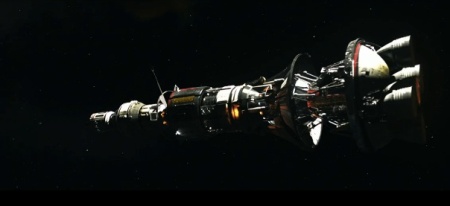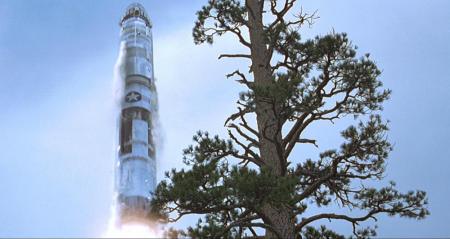NOTICE: Spoilers will appear in this review! If you ever read the book by Ayn Rand, you know already how the plot progresses. If not, you may want to avoid reading this.
(ABOVE: The “gold” “Steelbook” of the Part III Blu-ray, available directly from the movie website.)
First, I have to admit that just getting this made at all is a tribute to the vision and persistence of John Aglialoro, CEO of exercise equipment manufacturer Cybex International. The story of how the films were made is very interesting reading. I’ve read bits and pieces in a variety of places, but I don’t know of one place where you can find the whole story.
The 1000+ page novel is not only too unwieldy for one film, but really, even for three, but the book breaks into three parts nicely, and that is how the films were written. Unfortunately, the limited funding available meant that each subsequent film had half the budget of the previous installment – $ 20 million, $ 10, and 5 million for the finale.
Aglialoro and company decided on something that I thought was a very poor idea: each film was made with a completely new cast. Now, there were no guarantees even Part II would be made, so I suppose securing commitments from the first cast for a project that would take five years was impossible. Still, one of the flaws of the film series is that each subsequent cast and director seemed less able than the one before.
Part I was pretty watchable. With Taylor Schilling as Dagny Taggart, and Grant Bowler as Hank Rearden, the main cast members were, if not A-list, certainly B list folks, all good at their craft. I didn’t really expect Schilling to be as good as she was, but she sold me on being Dagny. (Of course, she is a big star of Orange Is The New Black – she got an Emmy Award for it last year – so getting a commitment from her for all three films may have been particularly difficult.) The rest of the cast pretty much lived up to my expectations as well, with particular standouts in Rebecca Wisocky as the Lillian Rearden you love to hate, and Graham Beckel as an appropriately-blustery Ellis Wyatt.
There were problems with updating the story to the present day. Rand gave no year for the story, except that it was assumed to be in the future; some folks who have studied it and her far more than I believe it was set in about the mid-1970s. It could have been an excellent period piece, set a few years or even a decade after the 1957 publication of the book. In that time period the railroads were the major lifeline moving goods from one end of the US to another. Today, while they certainly are still a major means of shipping, trucks and aircraft have become much more important.
Placing it in the present day, or in the near future, meant a little hand-waving for making the railroads so vital to the welfare of the country. That was accomplished by making one of the effects of the stifling socialist federal government be to raise oil prices so high as to ground planes, trucks and most personal vehicles. In Rand’s world, pretty much every country outside of the US is socialist or communist, their economies are failing, and we are shipping aid to many of them – even though our own people need things just as much, or more.
Analyzing the book’s themes is beyond the scope of this little piece. What I mostly want to talk about is how I thought the final installment was successful in achieving Aglialoro’s (and Rand’s) aims, and places where it seemed to be lacking.
On the plus side, screenwriter/director James Manera (who wrote the screenplay with Aglialoro and Herman Kaslow) did a pretty fair job of taking hundreds of pages of dialogue, plot and description and distilling it down to its essence. I think a movie of 99 minutes is too short, but whether that length was determined by money, time, or intended pacing, I have no idea. The essential themes are there. Galt’s broadcast speech (which takes about three hours to read out loud) was cut to a few minutes, but still achieves most of the intention of the original, I think. The cast – most of whom certainly are of the category of “where did I see that guy before” delivered the lines with conviction. Rand’s prose doesn’t translate to the contemporary vernacular very well, so it sounds a little stilted; but some of it reads that way in the novel, as well. Rand’s Producers are not like most film characters – they think before the speak, they can make well-reasoned arguments, and they are pretty adept at leaving emotion out of their discussions. That’s rare in TV and film nowadays, where action and emotion are the keys to success in the big blockbusters that are rolled out every summer.
Trouble is, that kind of dialogue isn’t enough to grab the audience. I knew it was coming, but I’ve read the book, a couple of times. A viewer without that experience could think the characters to be cold and dry. They are passionate people, but about their work, and the things they create – that’s harder to bring out, I think, in the time available in the film.
Pacing was odd. The movie is a series of short scenes, with some connective narration. There’s a lot of plot, and not enough time to show it to you. The narration helps to move the plot along but the depth is missing. When the Taggart Bridge collapses, we learn about it after the fact, and it is more of an intellectual problem for the cast than something that essentially cuts the entire country in two. Short-scene pacing can work, but to make the end of the film exciting, it would need to be picked up there, and instead, the final scenes feel longer and not very dramatic.
I happen to think Rand’s ending wasn’t optimal, but through the book she describes the continuing degrading of services of all kinds – food, electricity, fuel, and makes a point in the final third of the book that the skyscrapers of New York City are only lit on the lower few floors. There is too little electricity to light the upper floors, let alone run elevators. The skyline at night should gradually be getting darker over the course of the three films, and we don’t see that. In fact, the way the final loss of power to New York (and apparently, the entire eastern seaboard) is by showing a scene from the air where blocks of lights go out one at a time. It takes a few seconds instead of minutes, and was obviously much less expensive, but it doesn’t make the audience feel the darkness that is overcoming the entire country – a darkness people feel powerless to stop.
The torture scene at the end, and Galt’s subsequent rescue, was hard to watch. It wasn’t as well done as on any one of dozens of TV shows, and gave a very B-movie mad scientist vibe. In 1957 such a torture device might have been new, but making a big deal about Project F as a secret crash program and then showing it as something better done in 1970s TV was laughable. In the book, at least the rescue has a feeling of urgency and drama. This film had none of that. Of course Dangy & Co. are going to save Gault!
I think I put my finger on the biggest flaw in this film and in the other two as well – and it’s not Rand’s fault, and not really so much the fault of the writers or directors, either. Unfortunately, much of what she warns us about is already here. The story is no longer a cautionary tale about what might happen – in some ways, what has already happened is worse than what is described in the book. If over half the voters in the US are willing to vote for bread and circuses already, we’ve lost. In 1957 I don’t think that was the case. The amount of money flowing back to certain segments of American society today is almost beyond imagining. Instead of the audience thinking, “We can’t let that happen here,” at best they are thinking, “It’s happening here just like that now. How can we possibly change it?”
The use of companies named after their founders – Taggart, Rearden, Wyatt, etc. – was deliberate. Like the original US car makers and many other manufacturers, these are companies built and driven by the vision of a single man. I think Rand was watching those kinds of companies begin to disappear around her in the 1950s, and without a single founder at the head to fight for a company, the kind of mergers and acquisitions in the book (and in real life) go on at a faster rate. Nationalizing those companies is the last step before their destruction.
Rand believed strongly in the power of individuals, and the free use of their minds to create. She saw the Communist takeover of her Russian homeland firsthand, and as the Soviet Union dragged itself out of the ashes of World War II and became a world power I am sure she feared the worst for all other countries. I don’t know what would happen if all the creative people in technical and artistic fields “went away” today. The globalism we see now is both a deterrent and a curse. Of course, if our scientists went on strike, those in China or Singapore or eastern Europe would still be creating. But could the US stand it? Right now we are seeing one of Rand’s predictions coming true – Wyatt’s shale oil has been so successful in the central US and Canada as to actually drop the price of oil to less than half of what it was two years ago – despite the efforts of the Federal government. We produce enough food to feed ourselves and others as well. Our country is considered still to be enough of a beacon of freedom to attract immigrants, legal and otherwise, in great numbers. But we are engaged in a constant battle with the Nanny State and the reach of the Federal Government. Rand said the only way to break that stranglehold was for the people who were running the motor of the world to stop. Of course, we never find out if Rand’s USA rises free from the ashes of its socialist government. That is the part of the book we must help to write.
Short addendum: One thing that could have helped this film immensely would have been a better score. A composer was hired – Elia Cmiral, who also scored Part I, but the mix put the score so far down, and the score itself was so uninteresting, that it didn’t help bring the audience through the emotional points at all. For more films that we realize, the score is so important as to be essential for us to feel with the characters. Unfortunately this score didn’t do that at all.


















